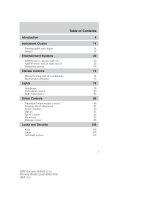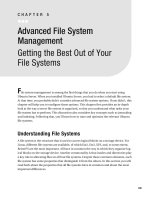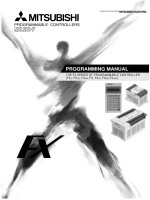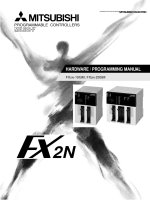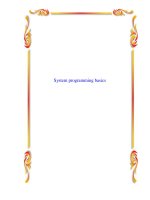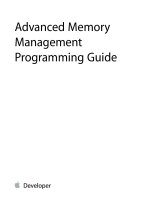Advanced hybrid system programming manual KT TA824
Bạn đang xem bản rút gọn của tài liệu. Xem và tải ngay bản đầy đủ của tài liệu tại đây (2.54 MB, 234 trang )
Model No.
KX-TA824
Thank you for purchasing a Panasonic Advanced Hybrid System.
Please read this manual carefully before using this product and save this manual for future use.
Advanced Hybrid System
Programming Manual
2 Programming Manual
Introduction
About this Programming Manual
The Programming Manual is designed to serve as an overall system programming reference for the
Panasonic Advanced Hybrid System.
It explains how to program this PBX using Panasonic proprietary telephones (PTs) or the KX-TA
Maintenance Console software.
The Programming Manual is divided into the following sections:
Section 1, Overview
Provides an overview of methods of programming the PBX, and information about password security.
Section 2, PT Programming
Serves as reference operating instructions when using a display PT to program the PBX.
Section 3, PC Programming—Introduction
Serves as reference operating instructions when using the KX-TA Maintenance Console software to
program the PBX.
Section 4, PC Programming—Opening Screen
Describes the options available when starting Maintenance Console.
Section 5, PC Programming—File
Explains the File menu, which lets you work with system data files, and view programming items.
Section 6, PC Programming—Connect
Describes the Connect menu, which offers options for connecting a PC to the PBX.
Section 7, PC Programming—View
Describes the View menu, which allows you to customize the operation of Maintenance Console.
Section 8, PC Programming—Utility
Describes the Utility menu, which contains options for performing system maintenance on the PBX.
Section 9, PC Programming—System Data Setting
Describes the options available on each setting screen of the Maintenance Console.
References Found in the Programming Manual
Installation Manual References
The Installation Manual provides instructions detailing the installation and maintenance of the PBX.
Sections from the Installation Manual are listed throughout the Programming Manual for your reference.
Programming Manual References
Related sections of the Programming Manual are listed for your reference.
Programming Manual 3
Feature Manual References
The Feature Manual explains what the PBX can do, as well as how to obtain the most of its many features
and facilities. Sections from the Feature Manual are listed throughout the Programming Manual for your
reference.
Operating Manual References
The Operating Manual describes how users can access commonly used PBX features and functions with
their PTs, single line telephones (SLTs), and Direct Station Selection (DSS) Consoles. Sections from the
Operating Manual are listed throughout the Programming Manual for your reference.
Links to Other Pages and Manuals
If you are viewing this Programming Manual with a PC, certain items are linked to different sections of the
Programming Manual and other PBX manuals. Click on a link to jump to that section.
Linked items include:
• Installation Manual References
• Programming Manual References
• Feature Manual References
• Operating Manual References
Trademarks
• Microsoft and Windows are either registered trademarks or trademarks of Microsoft Corporation in the
United States and/or other countries.
• Celeron and Intel are trademarks or registered trademarks of Intel Corporation or its subsidiaries in the
United States and other countries.
• All other trademarks identified herein are the property of their respective owners.
• Screen shots reprinted with permission from Microsoft Corporation.
4 Programming Manual
List of Abbreviations
A
AA Automated Attendant
APT Analog Proprietary Telephone
B
BGM Background Music
BV Built-in Voice Message
C
CO Outside (CO) Line
COS Class of Service
CPC Calling Party Control
D
DIL Direct In Line
DISA Direct Inward System Access
DND Do Not Disturb
DSS Direct Station Selection
DTMF Dual Tone Multi-Frequency
E
EFA External Feature Access
G
GRP Group
I
IRNA Intercept Routing—No Answer
L
LCS Live Call Screening
O
OGM Outgoing Message
P
PT Proprietary Telephone
S
SLT Single Line Telephone
SMDR Station Message Detail Recording
T
TA M Telephone Answering Machine
TRS Tol l R e striction
V
VM Voice Mail
Programming Manual 5
Table of Contents
1 Overview 11
1.1 Introduction 12
1.1.1 Introduction 12
2 PT Programming 13
2.1 PT Programming—Instructions 14
2.2 PT Programming—Procedures 17
[000] Date & Time 17
[001] System Speed Dialing Number 18
[002] System Password 18
[003] DSS Console Jack Assignment 19
[004] Console Paired Telephone 20
[005] One-touch Transfer Using a DSS Button 20
[006] Time Service Switching Mode 20
[007] Time Service Start Time 21
[008] Operator Assignment 21
[009] Extension Number 22
[010] LCD Time Display 22
[011] System Speed Dialing Name 23
[100] Hunting Group Set 23
[101] Hunting Type 24
[102] DTMF Integration Port 24
[103] DTMF Integration 25
[104] SLT Hold Mode 25
[105] Conference Tone 25
[106] External Pager Access Tone 25
[107] DTMF Receiver Check 26
[108] Flash/Recall Mode for a Locked Extension 26
[109] CO Indicator 26
[110] Flash/Recall Key Mode 27
[111] Music on Hold 27
[112] DSS Lamp Mode 27
[115] Extension Ring Tone Pattern 27
[117] Call Pickup Tone 28
[118] Pulse Restriction 28
[119] Redialing after Pulse to Tone Conversion 28
[128] Ringback Tone Pattern 28
[130] VM 1 APT Port 29
[131] VM 2 APT Port 29
[142] SLT Ring/Silence Ratio 30
[143] SLT Ring Bell-on Time 30
[150] SLT Caller ID Signaling Type 30
[151] SLT Caller ID Line Access Number 31
[152] Automatic Time Adjustment 31
[200] Hold Recall Time 31
[201] Transfer Recall Time 31
[202] Call Forwarding Start Time 32
[203] Hot Line Waiting Time 32
[204] Call Duration Counter Start 32
[205] CO-to-CO Line Call Duration 32
[206] Dialing Start Time 33
[208] Inter-digit Time 33
[211] No Dial Disconnection 33
[214] BV Recording Time 33
[215] Common/Personal BV OGM Recording Time 34
6 Programming Manual
[300] Carrier Exception Code 34
[301] TRS—System Speed Dialing Class 34
[302-305] TRS—COS 2-5 Denied Code 35
[306] TRS—Exception Code 35
[309] Emergency Number 36
[310] Account Code 36
[311] Automatic Pause Insertion Code 37
[312] TRS—Extension Lock Class 37
[400] CO Line Connection 37
[401] Dial Mode 38
[402] Pulse Speed 38
[403] Host PBX Access Code 39
[404] CO Line Group Number 39
[405-407] Flexible Outward Dialing—Day/Night/Lunch 40
[408-410] Flexible Ringing—Day/Night/Lunch 40
[411-413] Delayed Ringing—Day/Night/Lunch 41
[414-416] CO Line Mode—Day/Night/Lunch 41
[417] Pause Time 43
[418] Flash/Recall Time 43
[419] Automatic Designated Line Access 44
[420] CPC Signal Detection—Incoming 44
[421] CPC Signal Detection—Outgoing 45
[422] Disconnect Time 45
[423] CO Line Ring Tone Pattern 46
[435] Local Carrier-based Voice Mail Signaling 46
[436] Local Carrier-based Voice Mail Access Dial 47
[437] Extension Access to Local Carrier-based Voice Mail 47
[438-440] DISA IRNA to BV—Day/Night/Lunch 48
[500] DISA Incoming Call Dial Mode 48
[501] DISA Built-in AA 48
[503] FAX Connection 49
[504] DISA Delayed Answer Time 49
[505] DISA Wait Time after OGM 49
[506] DISA Busy Mode 50
[507] DISA Intercept Mode 50
[508] DISA Ring Time before Intercept 50
[509] DISA Ring Time after Intercept 51
[510] DISA No Dial Mode 51
[511] DISA Security Mode 51
[512] DISA Security Code 52
[513] Cyclic Tone Detection 53
[514] FAX Tone Detection 53
[515] Intercept Time for Internal DISA 53
[516] DISA Incoming Assignment 54
[517] DISA AA Wait Time 54
[518] DISA Tone after Security Code 54
[530] DISA Security Code Digits 55
[531] DISA Ringback Tone 55
[540-549] 3-level AA Assignment 55
[599] Clear All OGMs of DISA 56
[600] Extension Group 56
[601-603] TRS-COS—Day/Night/Lunch 56
[604] Extension Name 57
[605] Account Code Mode 57
[606] Call Transfer to CO Line 58
[607] Call Forwarding to CO Line 58
[608] Executive Busy Override 58
[609] DND Override 59
[610] Paralleled Telephone 59
[611] TAM Extension 59
Programming Manual 7
[612] Room Monitor 60
[615] LCD Language 60
[617] Wireless PT Port Assignment 60
[618] Message Waiting for Another Extension 61
[619] SLT Message Waiting 61
[620] LCS Recording Mode Set 61
[621] BV Resource 62
[622] BV for Extension 62
[625] BV Access Code through CO Line 63
[626] BGM Control for APT 63
[627] SLT Ring Wait Time for New Call 64
[628] SLT Caller ID 64
[629] SLT Fixed Bell Pattern 64
[700-702] Doorphone Ringing—Day/Night/Lunch 65
[703-705] Door Opener—Day/Night/Lunch 65
[706] Doorphone Ring Tone Pattern 66
[707] Doorphone Access Tone 66
[708] Doorphone Ring Time 67
[709] Door Open Duration 67
[710] Doorphone Ring/Chime 67
[711] Doorphone Chime Assignment 68
[712] Doorphone Chime Pattern 68
[800] SMDR RS-232C Parameter 68
[801] SMDR Parameter 69
[802] Incoming/Outgoing Call Selection for Printing 70
[803] Secret Number SMDR Print Suppression 70
[804] System Data Dump 70
[805] SMDR Account Code 71
[806] SMDR Language 72
[807] BV Total Recording Time 72
[808] BV Card Initialization 72
[900] Caller ID 72
[901] Caller ID Area Code 73
[902] Caller ID Modification for Local Calls 73
[903] Caller ID Modification for Long-distance Calls 74
[904] Caller ID Log Priority 74
[906] Caller ID SMDR Format 74
[907] Caller ID SMDR Printout 75
[908] Call Waiting Caller ID Time 75
[909] Common Area Call Log Check 75
[913] Call Waiting Caller ID Assignment 76
[914] Call Waiting Caller ID CAS Receive Time 76
[915] Caller ID Checksum 77
[963] Call Forwarding Selection 77
[966] TRS Check after Answering 77
[967] TRS Check Time after Answering 78
[968] KX-T7700 Series Incoming Lamp Control 78
[998] Firmware Version 78
[999] System Data Clear 79
3 PC Programming—Introduction 81
3.1 Introduction 82
3.2 PC Programming 82
3.2.1 Installing and Starting KX-TA Maintenance Console 82
3.3 Software Modes 82
3.4 Status Bar 84
3.5 Access Levels 85
3.6 Standard Buttons 85
8 Programming Manual
4 PC Programming—Opening Screen 87
4.1 Software Modes 88
5 PC Programming—File 91
5.1 New 92
5.2 Open 92
5.3 Close 92
5.4 Save 93
5.5 Save As 93
5.6 File Transfer PC to PBX 93
5.7 File Transfer PBX to PC 94
5.8 Program List 94
5.9 Print 95
5.10 Print ALL 95
5.11 Exit 96
6 PC Programming—Connect 97
6.1 Connect 98
6.2 Disconnect 101
6.3 Profile Setup 102
6.4 Profile Editor 102
7 PC Programming—View 107
7.1 Tool Bar 108
7.2 Programmer Code Change 108
7.3 Screen Customize 109
7.4 System Data Setting Menu 109
8 PC Programming—Utility 111
8.1 Firmware Upgrade 112
8.2 Quick Setup 113
8.3 System Reset 116
8.3.1 Normal 116
8.3.2 Default 117
8.4 System Data Clear 117
8.5 DISA OGM Clear 118
8.6 BV Card Initialization 118
9 PC Programming—System Data Setting 119
9.1 System [1] 120
9.1.1 Date & Time [1-1] 120
9.1.2 Main [1-2] 121
9.1.3 Numbering Plan [1-3] 124
9.1.4 Time Service [1-4] 125
9.1.5 Time Service [1-4] Time Setting 126
9.1.6 Account Codes [1-5] 128
9.1.7 Timers [1-6] 129
9.1.8 SMDR [1-7] 133
9.1.9 Carrier Exception Codes [1-8] 138
9.1.10 Automatic Pause Insertion Codes [1-9] 139
9.1.11 Detail [1-10] 140
Programming Manual 9
9.2 Extension [2] 146
9.2.1 Main [2-1] 146
9.2.2 Feature settings [2-2] 154
9.2.3 PT personal settings [2-3] 162
9.2.4 Flexible Buttons [2-4] 167
9.2.5 Flexible Buttons [2-4] CO buttons 169
9.2.6 Flexible Buttons [2-4] PF buttons 171
9.2.7 Flexible Buttons [2-4] Message button 172
9.2.8 DSS Console [2-5] 173
9.2.9 DSS Console [2-5] DSS buttons 176
9.2.10 DSS Console [2-5] PF buttons 178
9.2.11 Extension Group [2-6] 178
9.3 CO [3] 180
9.3.1 Line Mode [3-1] 180
9.3.2 Incoming / Outgoing [3-2] 181
9.3.3 Detail [3-3] 183
9.3.4 Local Carrier-based VM [3-4] 188
9.4 System Speed Dialing [4] 190
9.4.1 System Speed Dialing [4-1] 190
9.5 TRS 192
9.5.1 Class of Service (COS) [5-1] 192
9.5.2 Denied Codes [5-2] 193
9.5.3 Exception Codes [5-3] 194
9.5.4 Emergency Number & Others [5-4] 195
9.6 DISA [6] 198
9.6.1 Automated Attendant [6-1] 198
9.6.2 Automated Attendant [6-1] AA dial 200
9.6.3 Settings [6-2] 201
9.6.4 Incoming Permission [6-3] 207
9.7 Doorphone [7] 208
9.7.1 Ringing & Door Opener [7-1] 208
9.7.2 Others [7-2] 210
9.8 BV [8] 214
9.8.1 Main [8-1] 214
9.8.2 Others [8-2] 216
9.9 Caller ID [9] 218
9.9.1 Main [9-1] 218
9.9.2 SLT Caller ID [9-2] 222
9.9.3 Call Log [9-3] 226
Index 229
10 Programming Manual
Programming Manual 11
Section 1
Overview
This section provides an overview of methods of programming
the PBX, and information about password security.
1.1 Introduction
12 Programming Manual
1.1 Introduction
1.1.1 Introduction
These programming instructions are designed to serve as an overall system programming reference for the
Panasonic Advanced Hybrid System. The PBX has default settings that can be changed to meet your
needs. These settings control the manner in which the PBX features described in this Programming Manual
function, and changing these settings is referred to as "system programming". System programming can be
performed by only one person at a time. A second person attempting to program the system will be denied
access to system programming.
Ways to program
There are 2 programming methods:
• PT (Proprietary Telephone) Programming
PT programming is described in Section PT Programming. An authorized administrator or the
manager can perform system programming by entering 3-digit programming numbers with a PT.
• PC Programming
PC programming is described in Section 3.2 PC Programming.
Password Security
To maintain system security, a password is required to perform system programming. When KX-TA
Maintenance Console is started for the first time, the Quick Setup utility will ask you to set the system
password. To avoid unauthorized access and possible fraudulent dialing, do not disclose the password.
Warning to the Administrator or Installer regarding the system password
1. Please inform the customer of the importance of the password and the possible dangers if it
becomes known to others.
2. To avoid unauthorized access and possible fraudulent dialing, maintain the secrecy of the
password.
3. We strongly recommend that you change the default password value to something else for reasons
of system security. It is best to use a password of 7 digits.
4. Please change the password periodically.
5. If a system password is forgotten, it can be found by loading a backup of the system data into a
PC, and checking the password using the KX-TA Maintenance Console software. If you do not have
a backup of the system data, you must reset the PBX to its factory defaults and reprogram it.
Therefore, we strongly recommend maintaining a backup of the system data. For more information
on how to back up the system data, refer to the on-line help that appears by selecting the Help
menu during PC programming. However, as system passwords can be extracted from backup
copies of the system data file, do not allow unauthorized access to these files.
Notes
This PBX has only one system password. It can be changed by either PT programming or PC
programming. For this reason, the password can consist of numerals only.
Programming Manual 13
Section 2
PT Programming
This section serves as reference operating instructions when
using a display PT to program the PBX.
2.1 PT Programming—Instructions
14 Programming Manual
2.1 PT Programming—Instructions
Required Telephone
PBX settings can be customized through system programming by using a proprietary telephone (PT) with
a display, such as the KX-T7731. An authorized administrator or the manager extension connected to
extension jack 01 can access system programming.
Buttons and Functions
Fixed Button (KX-T7700 series) Function
PREV (PREVIOUS)
NEXT
SECRET
STORE
PAUSE
PROGRAM
END
SELECT
FLASH
–
–
2.1 PT Programming—Instructions
Programming Manual 15
Entering System Programming Mode
Using a PT to perform system programming allows an authorized administrator to set a wide range of PBX
features and parameters. To enter system programming mode, the system password is required. With the
system password, all system programming is accessible.
Notes
means default value throughout these programming instructions.
Entering Manager Programming Mode
Using a PT to perform manager programming allows the manager extension (extension jack 01) to set
certain PBX features and parameters. To enter manager programming mode, the extension password for
the manager (manager password) is required.
With the manager password, the following 4 system programming settings are accessible:
• [001] System Speed Dialing Number
• [011] System Speed Dialing Name
• [512] DISA Security Code
• [530] DISA Security Code Digits
Notes
• The system password may be entered instead of the manager password.
• With the manager password, the manager can also set a password to each extension. For more
information on how to assign a password to each extension including the manager password, refer
to the Operating Manual ( 2.1.7 System Feature Assignment).
CLEAR
Fixed Button (KX-T7700 series) Function
#
System Password for
Administrator
—for PT Programming
Programming No.
3 digits
1234
Programming No.
3 digits
Extension Password for Manager
—for PT Programming
#
2.1 PT Programming—Instructions
16 Programming Manual
Entering Characters
The PT's dialing buttons can be used to enter characters when storing a name or message. The following
tables depict the available characters:
Table 1 (Alphabet mode)/Table 2 (Numeral mode)
[Example of Entering Characters]
To enter "Ann":
Notes
• To toggle between "Alphabet mode" and "Numeral mode", press SELECT.
• To move the cursor right, press .
• To delete all characters, press CLEAR. To delete a character, press .
A
nn
6
(5 times)
6
(5 times)
2
OR
2.2 PT Programming—Procedures
Programming Manual 17
2.2 PT Programming—Procedures
Notes
• means default value throughout these programming instructions.
• means to select "All" throughout these programming instructions.
• The following are displayed when you store a number, such as a telephone number, or feature
number:
P: PAUSE; -: CONF; F: FLASH/RECALL; [ ]: INTERCOM
x: PAUSE (substitutes for any number [i.e., wild card])
• To return to the previous programming item, press .
• To correct a wrong entry, press CLEAR and then enter the new input.
• To delete a stored parameter, press CLEAR, enter the new input, and then press STORE.
• Press or to scroll the display.
• Some programs cannot have a value left empty.
[000] Date & Time
Selects the date and time of the PBX. The date and time will be shown on the displays of PTs and SMDR.
Conditions
• The clock starts immediately after the STORE button is pressed.
• The PBX supports years from 2000 to 2099.
Feature Manual References
1.1.43 Display Information
1.1.112 Station Message Detail Recording (SMDR)
0 00
NEXT
year
(00
…
99) (
Jan.
…
Dec.
)
SELECT
➞
➞ ➞ ➞
➞ ➞
hour
(1
…
12) (00
…
59) (AM/PM)
day
(1
…
31)
(
Sun
…
Sat
)
SELECT
minute
STORE END
SELECT
05
12 00
1
Jan.
Sat AM
2.2 PT Programming—Procedures
18 Programming Manual
[001] System Speed Dialing Number
Used to store frequently dialed numbers. These numbers are available for all extension users when making
or receiving calls.
A maximum of 100 System Speed Dialing numbers (e.g., telephone numbers, feature numbers) can be
programmed.
Conditions
• An Outside (CO) Line Access number (9, 81 through 88) should be included before the phone
number. When dialing, a pause will automatically be inserted after the Outside (CO) Line Access
number.
• When storing an account code assigned in [310] Account Code, enter and the account code
after an Outside (CO) Line Access number.
Programming Manual References
[011] System Speed Dialing Name
[310] Account Code
Feature Manual References
1.1.111 Secret Dialing
1.1.113 System Speed Dialing
[002] System Password
Specifies the system password used to access system programming.
WARNING
To maintain system security, a password is required to perform system programming.
To avoid unauthorized access and possible fraudulent dialing, do not disclose the
password.
Warning to the Administrator regarding the system password
1. Please inform the customer of the importance of the password and the possible dangers if it
becomes known to others.
0 0 1
NEXT
speed dialing no.
phone no.
STORE END
Max. 32 digits
(0
…
9, , #, P, –, F, [ ])
(00
…
99)
To continue
To continue
SELECT
NEXT PREV
or
All-Not stored
0 0 2
NEXT
password
STORE END
4-7 digits
(0000
…
9999999)
1234
2.2 PT Programming—Procedures
Programming Manual 19
2. To avoid unauthorized access and possible fraudulent dialing, maintain the secrecy of the
password.
3. We strongly recommend that you change the default password value to something else for reasons
of system security. It is best to use a password of 7 digits.
4. Please change the password periodically.
5. If a system password is forgotten, it can be found by loading a backup of the system data into a
PC, and checking the password using the KX-TA Maintenance Console software. If you do not have
a backup of the system data, you must reset the PBX to its factory defaults and reprogram it.
Therefore, we strongly recommend maintaining a backup of the system data. For more information
on how to back up the system data, refer to the on-line help that appears by selecting the Help
menu during PC programming. However, as system passwords can be extracted from backup
copies of the system data file, do not allow unauthorized access to these files.
Notes
This PBX has only one system password. It can be changed by either PT programming or PC
programming. For this reason, the password can consist of numerals only.
Programming Manual References
2.1 PT Programming—Instructions
3.2 PC Programming
Feature Manual References
1.1.99 PC Programming
1.1.103 PT Programming
[003] DSS Console Jack Assignment
Selects the number of the extension jack that the DSS Console is connected to.
Conditions
• To delete (disable) an extension jack number, press CLEAR in the extension jack number step.
• The same jack number cannot be assigned to 2 DSS Consoles.
• Do not assign extension jack 01 (manager extension) as the DSS Console jack.
• The extension jack number preassigned as a paired telephone in [004] Console Paired Telephone
should not be assigned in this program.
Programming Manual References
[004] Console Paired Telephone
Feature Manual References
1.1.54 Extension Jack Configuration
0 0 3
NEXT
DSS console no.
extension jack no.
STORE END
(1
…
2) (02
…
24/ Disable)
NEXT PREV
or
To continue
2.2 PT Programming—Procedures
20 Programming Manual
1.1.59 Fixed Buttons
[004] Console Paired Telephone
Selects the extension jack number of the PT to be used in pair with the DSS Console.
Conditions
• To delete (disable) an extension jack number, press CLEAR in the extension jack number step.
• The extension jack number preassigned as a DSS Console in [003] DSS Console Jack Assignment
should not be assigned in this program.
• An SLT cannot be paired with the DSS Console.
Programming Manual References
[003] DSS Console Jack Assignment
Feature Manual References
1.1.54 Extension Jack Configuration
1.1.59 Fixed Buttons
[005] One-touch Transfer Using a DSS Button
Selects how an outside (CO) line call is transferred to an extension using a DSS button.
Notes
With Transfer: Press the DSS button to transfer an outside (CO) line call.
Without Transfer: Press the TRANSFER button, then the DSS button to transfer an outside (CO) line
call.
Feature Manual References
1.1.25 Call Transfer—To Extension
1.1.59 Fixed Buttons
[006] Time Service Switching Mode
Selects whether the time service mode is switched between day, lunch, and night manually or automatically.
0 0 4
NEXT
DSS console no.
extension jack no.
STORE END
(1
…
2) (01
…
24/ Disable)
NEXT PREV
or
To continue
0 0 5
NEXT
SELECT
STORE END
( With Transfer/
Without Transfer)
0 0 6
NEXT
SELECT
STORE END
( Manual/Automatic)
2.2 PT Programming—Procedures
Programming Manual 21
Programming Manual References
[007] Time Service Start Time
Feature Manual References
1.1.114 Time Service
[007] Time Service Start Time
Enables the start times of each time service mode and end time of lunch mode for each day of the week.
Conditions
• This program is available when switching mode is enabled in automatic mode in [006] Time Service
Switching Mode.
• * Pressing SELECT shows the previous entry. When the display shows "None", press SELECT to
set the start time.
Programming Manual References
[006] Time Service Switching Mode
Feature Manual References
1.1.114 Time Service
[008] Operator Assignment
Selects the extension jack number to be designated as the operator.
Conditions
• To delete (disable) an extension jack number, press CLEAR in the extension jack number step.
0 0 7
NEXT
SELECT
(00
…
59)
(AM/PM)
(Day/Night/
Lunch-start/
Lunch-end)
minute
STORE END
SELECTSELECT
(Every day)
NEXT PREV
or or
(1
…
12)
or
hour
To remain the settings unchanged,
keep pressing SELECT until "None" is displayed
To go to another day of the week
To go to another mode
➞ ➞
➞
(Sun
…
Sat)
SELECTSELECT
*
Every day,
Day: 9:00 AM, Night: 5:00 PM,
Lunch-start
: None,
Lunch-end
: None
0 0 8
NEXT
extension jack no.
STORE END
(01
…
24/Disable)
jack 01
2.2 PT Programming—Procedures
22 Programming Manual
Feature Manual References
1.1.87 Operator/Manager Features
[009] Extension Number
Specifies an extension number for each extension.
Conditions
• The same extension number cannot be entered for 2 different extension jacks.
Programming Manual References
[604] Extension Name
Feature Manual References
1.1.43 Display Information
1.1.57 Feature Numbering
1.1.69 Intercom Call
[010] LCD Time Display
Selects the time format shown on the displays of PTs while on-hook.
Conditions
• The following settings and features use 12-hour format even if 24-hour format is assigned in this
program:
[000] Date & Time
[007] Time Service Start Time
1.1.112 Station Message Detail Recording (SMDR)
1.1.115 Timed Reminder
Programming Manual References
[000] Date & Time
[007] Time Service Start Time
Feature Manual References
1.1.43 Display Information
0 0 9
NEXT
extension jack no. extension no.
STORE END
(01
…
24) (100
…
199)
SELECT
NEXT PREV
or
To continue
To continue
extension jack no. 01-24=
extension no. 101-124
0 1 0
NEXT
SELECT
STORE END
( 12/24 h)
2.2 PT Programming—Procedures
Programming Manual 23
1.1.112 Station Message Detail Recording (SMDR)
1.1.115 Timed Reminder
[011] System Speed Dialing Name
Specifies a name for the System Speed Dialing number. The name will be displayed when making a call by
using the System Speed Dialing feature. It will also be displayed when a matching number is received with
the Caller ID feature.
Conditions
• * A name can be stored using a PT's dialing buttons. The displayed character varies depending on
the number of times that the dialing button is pressed. It is possible to toggle between "Alphabet
mode" and "Numeral mode" by pressing SELECT.
Programming Manual References
2.1 PT Programming—Instructions—Entering Characters
[001] System Speed Dialing Number
Feature Manual References
1.1.113 System Speed Dialing
[100] Hunting Group Set
Enables the redirection of calls to an idle member of the same extension group when the called extension
is busy.
Programming Manual References
[600] Extension Group
Feature Manual References
1.1.67 Idle Extension Hunting
0 1 1
NEXT
speed dialing no. name*
STORE END
(00
…
99) Max.
16 characters
SELECT
NEXT PREV
or
To continue
To continue
All-Not stored
1 0 0
NEXT
extension group no. name*
STORE END
(1
…
8/ )
SELECT
SELECT
NEXT PREV
or
To continue
To continue
(Enable/
Disable)
2.2 PT Programming—Procedures
24 Programming Manual
[101] Hunting Type
Selects the hunting type for each group.
Notes
Circular: Circulates until the call is answered.
Terminate: Terminates at the last extension.
Conditions
• This program is available when the extension group is enabled in [100] Hunting Group Set.
Programming Manual References
[100] Hunting Group Set
[600] Extension Group
Feature Manual References
1.1.67 Idle Extension Hunting
[102] DTMF Integration Port
Enables the extension jack number(s) (07, 08, 15, 16) to be connected to a Panasonic VPS and specified
as the voice mail ports.
Feature Manual References
1.1.121 Voice Mail Inband (DTMF) Integration
1 0 1
NEXT
extension group no. name*
STORE END
(1
…
8/ )
SELECT
SELECT
NEXT PREV
or
To continue
To continue
( Terminate/
Circular)
1 0 2
NEXT
extension jack no. name*
STORE END
(07, 08, 15, 16/ )
SELECT
SELECT
NEXT PREV
or
To continue
To continue
(Enable/
Disable)
2.2 PT Programming—Procedures
Programming Manual 25
[103] DTMF Integration
Enables Inband (DTMF) Integration between the VPS and the PBX when a KX-TVS series VPS/KX-TVA
series VPS is connected to the PBX. The VPS and PBX communicate with each other by sending DTMF
signals.
Conditions
• In order to select "Enable" in this program, [130] VM 1 APT Port and [131] VM 2 APT Port should
first be set to "Disable".
• Please refer to 1.1.121 Voice Mail Inband (DTMF) Integration in the Feature Manual for details
about such as DTMF status signals.
Programming Manual References
[102] DTMF Integration Port
Feature Manual References
1.1.121 Voice Mail Inband (DTMF) Integration
[104] SLT Hold Mode
Selects how calls are held and transferred with an SLT when the Recall/hookswitch is pressed for less than
1000 ms.
Feature Manual References
1.1.15 Call Hold
[105] Conference Tone
Enables the PBX to send a confirmation tone before starting or ending a conference call established by the
Conference feature or Executive Busy Override feature.
Feature Manual References
1.1.33 Conference
1.1.50 Executive Busy Override—Extension
1.1.51 Executive Busy Override—Outside (CO) Line
[106] External Pager Access Tone
Enables the PBX to send a confirmation tone to the external pager before a paging announcement.
1 0 3
NEXT
SELECT
STORE END
(Enable/ Disable)
1 0 4
NEXT
SELECT
STORE END
( Hold-1/Hold-2/
Hold-3)
1 0 5
NEXT
SELECT
STORE END
( Enable/Disable)
1 0 6
NEXT
SELECT
STORE END
( Enable/Disable)
